1. Introduction
Wheat (Triticum aestivum) is the most important winter cereal in Argentina. Foliar diseases such as leaf rust (Puccinia triticina) and tan spot (Drechslera tritici repentis), and head diseases such as bunt and Fusarium head blight (Fusarium graminearum) cause large reductions in yield and grain quality. Consequently, in order to reduce the development of epidemics and minimize economic damage, Sugliano1 emphasizes the timely application of fungicides, preventing the pathogen from establishing in the crop, overcoming the economic damage level.
Particularly in the case of fusarium head blight, the application should be preventive, paying attention to the relative humidity and daily temperature records prior to flowering, which are decisive for the pathogen, if present, to infect the crop. Wet heads for 2 to 3 days and temperatures between 10 °C and 30 °C, with an optimum around 25 °C, are sufficient to produce infection2. In addition, its control has three limitations: the head structure, the method of application, and the time of application, the latter being the most important. The vertical orientation of the head makes its treatment more difficult, unlike diseases that occur in the horizontal parts of a plant, such as the leaves3. Therefore, the structure and physiology of the head make the fungicide products act mainly as contact, and not systemic, so they must be applied immediately before the infection occurrence2. In this regard, Oseki and Kunz4 recommend a minimum coverage of 30 to 40 droplets per cm2 for systemic fungicide applications, while Meneghetti5 and Gandolfo and others6 agree that 60 impacts per cm2 are necessary when performing fungal treatments to achieve biological efficacy, leaving aside the coverage effects, characteristic of the droplet population, droplet size, relative amplitude, distribution uniformity and recovery of the applied solution on the application object. However, in addition to the droplet density, the droplet diameter is also important for this type of product. Cunha and others7 emphasize the percentage of coverage for disease control and not the droplet density. Working in the management of Asian soybean rust, they found a greater number of droplets when using a conventional hollow cone, while the coverage percentage was similar for all the evaluated nozzles, with no differences in disease control. In this regard, Marquez8 mentions that smaller droplets as a whole are more likely to deposit than the same volume represented by a single larger drop. In agreement with this author, Antuniassi and Boller9 recommend a droplet diameter (volume median diameter- vmd) between 200 μm and 300 μm (fine to medium droplets)10 as ideal for systemic fungicide applications, relating the droplet size with the deposition capacity thereof, being that fine droplets (between 106 µm and 235 µm)10 provide greater coverage, but have greater drift risk. Herrera Pratt and others11 found smaller droplet diameter, higher density, and coverage for hollow cone nozzles compared to flat-fan nozzles, under controlled conditions. However, the latter had greater uniformity, probably due to the distribution profile. Galvez and others12 presented similar results on a soybean crop in R5, associating the best distribution in the canopy of hollow cone nozzles with the highest number of impacts of smaller vmd, both in the upper and lower stratum; while double fan nozzles, with a spectrum of fine to medium droplets (between 106 µm and 340 µm)10, did not penetrate greatly after 0.20 m. For their part, Derksen and others13 obtained better coverage percentages, both on the head and on the flag leaf of a wheat crop, when sprayed with fine droplets (between 106 µm and 235 µm)10. In addition, these authors found that deposition on the head increased when the boom was 30º forward, compared to the vertical orientation, although deposition on the flag leaf was reduced. Wolf and Caldwell14 showed that thick droplets (between 341 µm and 403 µm)10 generated by air-induced nozzles and two nozzle arrangements (one forward and one back) increase deposition in vertical and horizontal targets of a cereal crop. They ensure that increasing the angle between the two nozzles also increases the deposits on those targets.
Villalba and others15 mention that the application success and the result of the control are directly related to the proper selection of spray nozzles and the correction of the application volume, together with the operational and climatic conditions. In this regard, Parkin and others16 suggest, for efficient control of head diseases, using nozzles angled back and a population of medium droplets (between 236 µm and 340 µm)10 or with induced air. The authors found a trend towards greater deposition on the rear face of the heads with respect to the front, for all the nozzles used. However, the air-induced fan, with an inclination of 10° back, presented the highest deposition on both sides, while the conventional fan presented the least. For their part, Halley and others17 recommend working with flat-fan nozzles oriented forward, with an inclination with respect to the horizontal of 30° downwards and assisted with an air current, ensuring a greater deposition and coverage on the head sides. In this regard, Elliott and Mann18 demonstrated that the deposits on wheat heads increased from 2.6 μl to 4.6 μl as the inclination of the flat-fan nozzle varied from 10° to 40°. Wolf and Peng19 ensure that the 60° angle nozzle significantly improves deposition on vertical targets, but not on horizontal.
Wolf and Caldwell20 mention that the nozzle type significantly affects deposition on both front and rear sides, and on the entire target. This statement was made after finding a similar recovery rate on the front face for the aixr and ai3070 nozzles, significantly higher than aittj60. However, ai3070 had a greater deposition on the rear face, resulting in a significantly higher total deposition than the others. Uniformity, indicated by the authors as the relationship between front and rare sides, was higher for ai3070 (1.5), similar to aittj60 (2.0) and significantly better than aixr (3.4). Nicholson and others21 found that the double flat-fan nozzles presented a greater head distribution uniformity than the conventional flat-fan nozzles, determining greater coverage and control of the disease. Similar results were reported by Oskan and others22 in the control of foliar and stem diseases of a wheat crop. However, the greater stem coverage with the double fan nozzles did not correspond with similar results in the flag leaf, where the flat-fan nozzles produced greater coverage, not being significantly different. Ferguson and others23 determined a higher droplet density and coverage with nozzles angled 30° forward and back when evaluating the behavior of symmetrical and asymmetric double fan nozzles. In addition, they indicated that the angle alternation in the asymmetric nozzles allowed maintaining the coverage percentages uniform against pressure variations with respect to the original arrangement. Olivet and others24 achieved the highest deposition on the stem with double fan nozzles, being the difference between conventional and air induction flat-fan nozzles of 73%. The authors attributed this behavior to the double spray profile of the double flat fan. Furthermore, the deposition achieved with the conventional flat-fan was the lowest, not different from the induced air flat fan.
Therefore, spraying is the most common and widespread form of application of phytotherapy products, but its results are variable and complex, which makes its evaluation important. Accordingly, the use of water-sensitive paper is an accessible and simple evaluation method that allows evaluating different parameters that affect the control deposition. In recent years, different forms of digital paper processing have been developed that allow quantifying, in addition to the number of impacts, the coverage, characteristics of the droplet population, and the amount of deposited product, which is expressed as deposition of the liquid sprayed per unit area. In this regard, Domper and others25 found that the image processing method overestimates the deposition percentage of air-induction nozzles when comparing conventional and induced air 80015 hollow cone nozzles, but it is still a suitable tool for decision-making at field level, given its simplicity and speed. Zhu and others26, using the DepositScan software, found that the diameter of the droplets differed from the reading made with a stereoscope microscope, and they assigned the inaccuracy to the droplet size, which gets smaller the bigger the drop, recommending higher resolution scanners. In addition, they indicated that some large droplets displayed on the paper could be the result of the overlap of several droplets, so the diameter of the droplets taken by the program would be the combination of the diameter of several small droplets and not a large one. However, drawbacks have also been found with smaller droplets. Accordingly, Stefanelo and others27 found droplet size discrepancies with the indicated by the manufacturers of these nozzles, when evaluating the behavior of flat-fan and hollow cone nozzles on a wheat crop. It may be related to the limitations of the water-sensitive paper in detecting small droplets. Similar results were observed by Bayer and others28 in aerial applications, where the water-sensitive paper was not able to detect very fine droplets (<60 µm)10 generated by electrostatic nozzles and rotary atomizers. Another way of evaluating spray systems is through chemical substances as tracers, which allow determining the amount of product actually deposited on the application target29. Their use is complex and they are not applicable at a productive level, but they provide greater accuracy25 and are very useful for avoiding accidental contamination of the water-sensitive paper by friction with wet surfaces, fingerprints and/or air moisture30. On the other hand, Porras Soriano31 and Dobson and King32 recommend using natural plant surfaces to evaluate the amount of deposited phytosanitary products, since the amount of retention in the leaves or other plant surfaces is usually different from artificial surfaces, such as water-sensitive paper collectors.
Considering the aforementioned, the purpose of this study is to evaluate the quality and uniformity of application of different types of nozzles on a wheat crop and to determine the deposition, calculated from the image digitization method and the determination by colorimetry using a spectrometer.
2. Material and methods
The tests were carried out at the Julio Hirschhorn Experimental Station (34 ° 59 'S, 57 ° 59' W) of the College of Agricultural and Forestry Sciences from Universidad Nacional de La Plata, located in the town of Los Hornos, La Plata, Argentina. Applications were made on a wheat crop (Triticum aestivum) in the early anthesis stage, Z61 state according to Zadoks and others scale33. For this purpose, an 8.4 m hydraulic spraying equipment was used, multiple nozzle holders distanced 0.525 m and a 0.38 m boom height from the head. The moving speed of the set was 2.45 ms-1, the working pressure was 300 kPa, and the application rate for all treatments was 103 l ha-1. Water was used for applications and a food-type tracer, Bright Blue (fd&c Blue No. 1) was added in a dilution of 13,073 g l-1.
The average weather conditions during the test were open skies, average temperature of 26 °C, relative humidity of 41%, and wind speed of 5 km h-1 with gusts up to 11.3 km h-1.
A 4x2 factorial design was used with ten randomly distributed repetitions. Four nozzle designs were evaluated, which defined the treatments: flat-fan 11002 (ap11002), hollow cone 8002 (txa8002), air induction symmetrical double fan 11002 (ai3030), and air induction asymmetric double fan 11002 (ai3070) (Table 1). For each of them, two measurement targets were established: one vertical (head), and one horizontal (flag leaf).
Vertical targets (heads) were evaluated using two methods: colorimetric tracer and water-sensitive paper. On the one hand, the spray deposition was determined by the quantification of the tracer added, according to the methodology presented by Palladini34 and as amended in the description of Palladini and others35. After the application and drying of the spray on the crop, ten heads were collected per repetition and placed in individual bottles. In the laboratory, the material samples were washed with 30 ml of distilled water to remove the tracer. The washing solution was placed in 50 ml falcon tubes and absorbance was read at a wavelength of 630 nm using a single axis spectrometer of uv-visible, metrolab brand, model 320. Absorbance data were transformed into solution concentration (mg l-1) using a calibration curve with standard solutions. The amount of plotter retained in the target, expressed in g ha-1, was determined depending on the dilution volume of the samples and the density of heads per hectare (3,000,000 heads ha-1). The deposit percentage on the head was calculated knowing the initial concentration of broth in the tank (mg l-1) and the application dose (l ha-1).
Table 1: Used nozzles and operating conditions of the spraying tractor. P: working pressure; q: nozzle flow; Va: moving speed of the set; va: application volume; T: treatment; ap11002: flat-fan nozzle 11002; txa8002: hollow cone nozzle; ai3030: air induction symmetrical double fan nozzle; ai3070: air induction asymmetric double fan nozzle
| Spray Nozzles | Pressure (kPa) | q (l min-1) | Va (ms-1) | VA (l ha-1) | Droplet class (µm)* | T |
| Albuz AP 11002® | 300 | 0.8 | 2.45 | 103 | Fine | AP11002 |
| Teejet TXA 8002® | 300 | 0.8 | 2.45 | 103 | Fine | TXA8002 |
| Hypro GAT 11002® | 300 | 0.8 | 2.45 | 103 | Thick | AI3030 |
| Teejet AI3070 11002® | 300 | 0.8 | 2.45 | 103 | Medium | AI3070 |
*classes of nozzle droplets according to asabe S572.110
Syngenta® 3" x 1" water-sensitive paper was used to characterize the droplet population that reached the target. Using a cylindrical tube resting on the head, four water-sensitive paper were placed simulating the head surfaces: front, rear, right and left. The paper was digitized with a resolution of 1200 dpi and processed using the cir 1.5 program. Count and calculation of the replaced variables was performed on the average of five measurement windows: 1) Droplet density cm-2; 2) Coverage (%) - Percentage of paper area covered with stains; 3) Deposition (%) referring to the estimated volume collected in the target and the volume applied by the sprayer ratio.
This latter evaluation method was also used to assess horizontal targets, simulating the flag leaf by placing sensitive papers on iron support at its height.
3. Results and discussion
The data analysis for all variables showed a significant interaction between measurement targets (head and flag leaf) and the nozzles, therefore, the analysis was partitioned to evaluate the effect of the different nozzles on the head and the flag leaf.
3.1 Droplet density and coverage
Figure 1 shows the average droplet density on the head and flag leaf per treatment. The txa8002 nozzle showed the highest values and the double fan showed the lowest, while ap11002 showed an intermediate behavior. This trend was partly reported by Herrera Prat and others11 and Derksen and others13, attributing these differences to the smaller droplet spectrum of the hollow cone nozzles compared to the others. Similar observations were made by Galvez and others12, explaining the better distribution in the canopy of the hollow cone compared to double fan nozzles. Smaller droplets are more likely to deposit than the same volume represented by larger droplets.
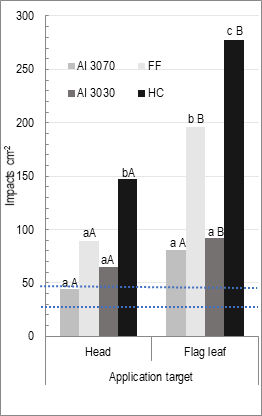
Figure 1: Droplet density on the head and the flag leaf for the different nozzles. ap11002: flat-fan 11002; txa8002: hollow cone 8002; ai3030: air induction symmetrical double fan 11002; ai3070: air induction asymmetric double fan 11002. The lowercase letters on the columns indicate significant differences (p≤0.05) according to the Tukey test between nozzles in each application target. Different capital letters on the columns indicate significant differences (p≤0.05) according to the Tukey test between application targets for each nozzle.
All treatments presented a higher droplet density on the flag leaf compared to the head, except for the significant difference with the nozzle ai 3070. Results also confirm the difficulty for droplets to reach the vertical target, linked to the structure of the head and its orientation, showing it is relatively easier to reach the horizontally oriented parts, such as the flag leaf3. The lower performance of the ai3070 and ai3030 nozzles is not consistent with the recommendations of Parkin and others16 regarding the use of air-angled nozzles and a population of medium or air-induced droplets for efficient control of head diseases. However, both in the head and in the flag leaf, all nozzles reached 30 to 40 droplets cm-2, recommended by Ozeki and Kunz4 to achieve biological efficacy in fungal treatments with systemic products. Nonetheless, the structure and physiology of the head make fungicide products act mainly as contact and non-systemic36, requiring at least 60 impacts cm-2 for their control, recommended by Meneghetti5 and Gandolfo and others6. In this sense, the alternative ai3070 does not achieve the necessary number of impacts, while ai3030 with 65 impacts/cm-2 barely reaches it, and the flat-fan and hollow cone nozzles exceed it by far.
The analysis of the droplet distribution on the different head surfaces (Figure 2) showed all the nozzles, except for ap11002, achieved the greatest number of impacts on the rear side of the head, although only txa8002 differed significantly. The backward angulation of the double fan nozzles, at 30º and 70º for ai3030 and ai3070, respectively, allows the sprayed jet to be mostly directed towards the rear of the head. Likewise, the characteristics of reduced droplet size and the effect of the 360º flow rotation of txa8002 determine that they move in multiple directions reaching the head throughout its surface. However, ap11002 presented the greatest number of impacts on the left side of the head, differing only from the front side. This was an unexpected result, partly due to the wind direction at the time of the test and the spray fan position regarding the target, showing greater incidence on the sides of the head. This behavior may come from the position of the nozzle regarding the boom, without angulation, defining a spray curtain with greater incidence on the sides of the head. Despite these observations, and in agreement with Parkin and others16, all nozzles presented a greater number of impacts on the rear face compared to the previous one.
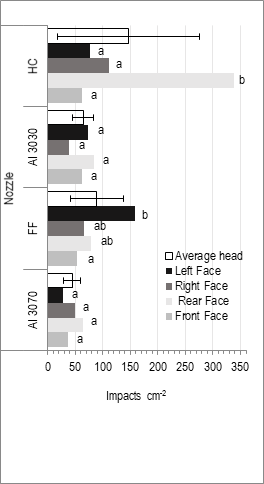
Figure 2: Droplet density on the head and the flag leaf for different nozzles. ap11002: flat-fan 11002; txa8002: hollow cone 8002; ai3030: air induction symmetrical double fan 11002; ai3070: air induction asymmetric double fan11002. Different lowercase letters on the columns indicate significant differences (p≤0.05) according to the Tukey test between head sides for each nozzle.
Standard deviation was used for the analysis of the distribution uniformity in the head. In this sense, the double fan nozzles presented greater uniformity between the head surfaces compared to txa8002 and ap11002. These results are similar to those of Nicholson and others21, who found a greater distribution uniformity on the head with the double flat-fan nozzles compared to the conventional fan. The nozzle txa8002 was the one with the greatest unevenness, while ap11002 had an intermediate behavior, at first, due to the triangular, symmetrical distribution profile, without large depressions in the central area, as reported by Herrera Prat and others11, who obtained similar results under controlled conditions.
If the relationship between the front and the rear face is taken as the uniformity distribution criterion, as proposed by Wolf and Caldwell20, the asymmetric double fan nozzle (0.97) showed the highest uniformity, followed by ai3030 (2.15) and ap11002 (3.23). Although values differ from those mentioned by the authors, the trend is similar, with the double fan nozzles being the most uniform.
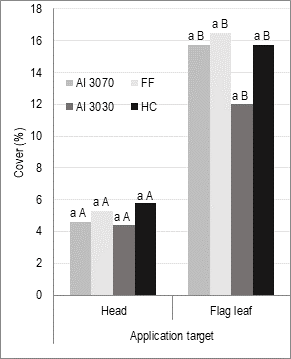
Figure 3: Coverage percentage on the head and the flag leaf for the different nozzles. ap11002: flat-fan 11002; txa8002: hollow cone 8002; ai3030: air induction symmetrical double fan 11002; ai3070: air induction asymmetric double fan11002. Different lowercase letters on the columns indicate significant differences (p≤0.05) according to the Tukey test between nozzles in each application target. Different capital letters on the columns indicate significant differences (p≤0.05) according to the Tukey test between application targets for each nozzle.
Regarding the coverage of the application targets for the different treatments (Figure 3), the trends were similar to those of droplet density, since the highest coverage was observed on the flag leaf, with significant differences regarding the head for all nozzles. In the head, the coverage percentages did not exceed 6%, while in the flag leaf they varied between approximately 12% and 16%. These differences can be explained, in part, as already mentioned, by the ease of the droplets to achieve horizontal targets, such as the flag leaf, as opposed to the vertical ones3. The low coverage percentages on the head could jeopardize the efficient control of fusarium head blight since the products used act mainly by contact on the anther filament from the beginning of anthesis.
In both vertical and horizontal targets, the nozzles had similar behavior, without significantly differentiating from each other. The higher density of impacts of the nozzle txa 8002 did not correspond to the same coverage percentage, confirming the reported by Da Cunha and others37, who, working on the management of Asian soybean rust, found similar coverage percentage for all nozzles when the droplet density achieved by the hollow cone nozzle was the highest. However, the results differ from those of Antuniassi and Boller9, who recommend fine droplets for the application of fungicides, since they provide greater coverage.
Conventional nozzles, txa8002 and ap11002, achieved a coverage percentage on the head slightly higher than angled nozzles, without significant differences. This trend is contrasted with the higher head coverage values of the double fan nozzles compared to the conventional flat fan, reported by Nicholson and others21, and Ozkan and others22. These last authors obtained opposite results in the flag leaf, with higher coverage percentages by the flat-fan nozzles, without significant differences, aligned with the observed in Figure 3. The lower percentages of angled nozzles differ from those reported by Halley and others17, who ensure greater coverage on the head sides due to the 30º inclination of the flat-fan nozzles. Depending on the results, it is possible to agree with what Derksen and others38) stated, that the best coverage percentages, both in the head and flag leaf, were obtained with fine droplets, representative of the ap11002 and txa8002 treatments. The double fan nozzles had a similar performance on the head, but not on the flag leaf, where ai3030 presented the lowest coverage percentage, in contrast to what was observed by Ferguson and others23, with better performance than symmetrical double fan.
Statistical analysis of the behavior of the different nozzles on the head sursides (Figure 4) showed a similar trend as for droplet density. However, the coverage percentages differed in part from the droplet density values. These discrepancies may be due to the great heterogeneity in the droplet spectrum of the evaluated nozzles, mentioned by Stefanelo and others27. txa8002, ai3070 and ap11002 presented the highest percentages on the rear face, corresponding to the number of impacts; but with ai3030 the front face was the one with the greatest coverage, associated with a greater diameter of the droplets that reached that surface compared to the rear, according to the author. On the double fan nozzles, on the other hand, the least coverage was observed on the head sides, being able to attribute this behavior to the nozzle angles (30º forward and 30º back for ai3030, and 30º forward and 70º back for ai3070) that spray mainly towards the front and rear sides. Towards the sides, the amount of sprayed liquid decreases according to the characteristic profile of the fan, and the greater distance to the target affects the path of the droplets at the ends of the fan, which tend to fall vertically as they move away, decreasing the overlap at 0.52 m between nozzles. Moreover, the lowest percentages were on the front face for conventional nozzles.
Despite these considerations, the nozzles maintained the uniformity observed in the variable droplet density. The angled nozzles were the most uniform, with standard deviation (σ) values of 3.1 for ai3070 and 4.2 for ai3030; while txa8002 with a deviation of 6.1 was the most uneven in the distribution between the head sides, and ap11002 had an intermediate behavior (σ=4.7). Taking into account what Ferguson and others23 mentioned regarding the asymmetric double fan nozzles, the coverage and its uniformity would be improved with boom angle alternation.
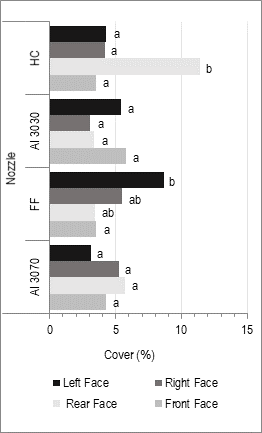
Figure 4: Coverage percentage on the head sides for the different nozzles. ap11002: flat-fan 11002; txa8002: hollow cone 8002; ai3030: air induction symmetrical double fan 11002; ai3070: air induction asymmetric double fan11002. Different lowercase letters on the columns indicate significant differences (p≤0.05) according to the Tukey test between head sides for each nozzle.
3.2 Deposition
Regarding product recovery on the head, no interaction was found between nozzles and evaluation methodology (Figure 5). The cir 1.5 software yielded higher values for all nozzles, with a significant difference regarding the tracer. These results confirm that the program, regardless of the droplet spectrum, overestimates the application deposition, agreeing with Domper and others25.
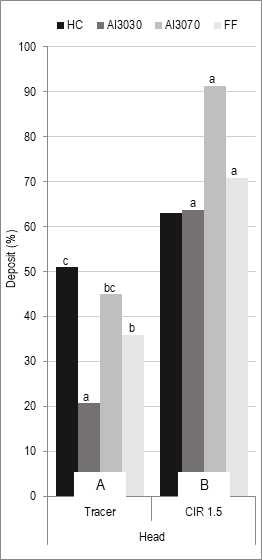
Figure 5: Broth deposit collected on the head according to valuation methodology for each nozzle. ap11002: flat fan 11002; txa8002: hollow cone 8002; ai3030: air induction symmetric double fan 11002; ai3070: air induction asymmetric double fan 11002. Different lowercase letters on the columns indicate significant differences (p≤0.05) according to the Tukey test between nozzles for each methodology. Different capital letters on the columns indicate significant differences (p≤0.05) according to the Tukey test between methodologies for each nozzle.
On the other hand, the image processing methodology did not show significant differences between the nozzles, although the difference between the highest and lowest deposition was 45%, being the lack of significance due to the great variability of the results. On the contrary, when using the tracer, the nozzles differed significantly from the rest of the treatments, but the results were highly stable, which partly indicates the reliability of the methodology. Accordingly, txa8002 presented the highest deposition, significantly different from ap11002 and ai3030, that had the lowest percentages, but with similar behavior to ai3070. These results have a similar tendency to coverage, where the hollow cone and double symmetric fan nozzles had the highest and lowest percentages, in agreement with Antuniassi and Boller9, who associated deposition with droplet size, fine droplets resulting in better coverage and penetration. However, this differs from Wolf and Caldwell14, who demonstrated that thick droplets increase deposition on vertical and horizontal targets. These last authors also assure that, as the angle between the double nozzles increases, target deposits increase, which was confirmed in this study by the higher deposition percentages of ai3070 compared to ai3030. The same was reported by Halley and others17, ascribing to the 60° angulation forward (30° down regarding the horizontal) a greater deposition and coverage on the head surfaces.
In the comparative analysis of the double fan nozzles with the conventional flat-fan, the results were uneven. ai3070 reached 25% more deposition compared to ap11002, while ai3030 produced 42% less deposition. In part, these values agree with Elliot and Mann39 regarding an increase in deposition as the nozzle angle increased from 10° to 40°. However, and according to the test results, the 30° inclination of the alternative ai3030 was not enough to improve the deposits, requiring greater angulation to improve them. Similarly, Olivet and others24 found 73% more deposition on the head when working with double fan nozzles tj60 8002, compared to flat-fan, attributing this improvement to the double spray profile. The results of this study show that the type of nozzle significantly affects the deposition on the target, in agreement with Wolf and Caldwell20. The combination of a targeted spray together with a reduced droplet size seems to be the best alternative to achieve a higher recovery rate on vertical targets, in atmospheric conditions compatible with that size, low wind speed, mild temperatures, and high relative humidity.
Agreeing with the deposition values obtained, and as previously mentioned, the use of water-sensitive paper and its subsequent analysis with cir1.5 significantly overestimate the deposition percentage compared to the tracer determination. In part, these differences can be attributed to the nature of the surfaces where the sprayed liquid is collected, mentioned by Porras Soriano31 and Dobson and King32, who recommend using natural plant surfaces, since the amount of liquid retained may be different from that of artificial surfaces, such as water-sensitive paper.
Table 2 shows the overestimation values for each nozzle, obtained from the ratio between deposition percentages of the two evaluated methodologies. The medium to thick droplet air induction nozzles presented the highest values, 3.06 and 2.03 for ai3070 and ai3030, respectively. A ratio of 1.24 for the nozzle txa8002 was the lowest. These results support that regardless of the nozzle, the digital analysis methodology of the water-sensitive paper overestimates the recovery rate, as aforementioned. However, this overvaluation is not the same for all nozzles. In agreement with the results reported by Domper and others25, the overestimation was higher for the air-induction nozzles compared to the conventional. These results do not coincide with what was reported by Zhu and others26, who assure that the inaccuracy gets smaller the bigger the droplet. These authors also indicate that some thick droplets displayed on the paper could be the result of the overlap of several droplets, the resulting diameter being much larger than that which correponds. These differences could be partly explained by the characteristics of the air-induced droplets, which impact and leave stains related to their volume and not the actual amount of water they contain. Moreover, when hitting the surface of the paper they break and generate new droplets with a volume that is repeatedly estimated25. Regarding the smallest droplets, the smallest overestimation of the program would be related to the smallest mass and, therefore, the least drag of the droplets on the target, regardless of the limitations of the water-sensitive paper in detecting small size impacts, mentioned by Stefanelo and others27 and Bayer and others28.
The correction of the deposition percentages of the flag leaf was carried out with the correction factors obtained (Table 2), to avoid overestimation of the program (Figure 6). Statistical analysis for the horizontal target showed significant differences between nozzles, with a similar trend to that observed in the head, beingtxa8002 the one with the highest percentage, with significant differences compared to ai3030, that presented the lowest value. The ap11002 and ai3070 nozzles had an intermediate behavior, without significant differences between each other, although the 70º angle of the asymmetric double fan nozzle improved the deposition on the head compared to the conventional flat fan, similarly to the results by Wolf and Peng19.
Table 2: Correction factor for each nozzle, obtained from the ratio between the values of cir1.5 and T.cir 1.5: image processing program; T: fluorimetric tracer. ap11002: flat fan 11002; txa8002: hollow cone 8002; ai3030: air induction symmetrical double fan 11002; ai3070: air induction asymmetric double fan 11002.
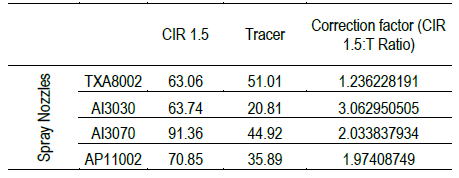
Even then, the deposition is relatively low, not exceeding values of approximately 50% of the product distributed per unit area when considering the treatment of the head. If the target was the flag leaf, the results would be worse, since only one treatment can slightly exceed 40% of the deposited product. The analysis would improve if vertical and horizontal targets were considered together. However, it is clear that multiple directions are an overall improvement over conventional nozzles in distribution uniformity, rather than the number of deposits on the target, which depends on different variables associated with nozzle design, such as the height of the boom, the distance between nozzles and the speed, due to the effect on the direction in which the droplets hit the head.
Considering the joint deposition of the head and the flag leaf, the hollow cone nozzle, with a spectrum of fine droplets and under favorable weather conditions, achieved the highest deposition, above 90%, confirming claims by Marquez8 and Antuniassi and Boller9. Meanwhile, ai3070 with medium droplets also had a good performance, close to 72%. These considerations are important when carrying out applications under adverse environmental conditions, needing to take the corresponding measures to carry out the application efficiently, reducing the risks of drift. The poor performance of the ai3030 nozzle, just over 37%, could be due in part to the thick droplet size and the 30º inclination, which is not enough to reach the head, for the working height established in the essay, differing from that reported by Wolf and Caldwell14, who assure that these same characteristics increase the deposition in the targets.
The ap11002 nozzle performed well, with a total deposition percentage of 67%, with the most uniform distribution between the head and the flag leaf. The good performance of this nozzle compared to the ai3030 does not agree to that mentioned by Derksen and others38 in terms of an increase in deposition on the head with the boom 30º forward from the vertical position.
The sprayed distribution on the head behaved differently according to the nozzle (Figure 7). ap11002 was the only one with significative differences between sides, however, txa8002 was the most uneven, due to the large deposition on the rear face of the head compared to the others. The trend was similar to that visualized by Nicholson and others21 in that double fan nozzles presented greater uniformity than conventional flat fan nozzles. Likewise, in reference to the fan nozzles, ai3070 presented the highest deposition compared to ai3030 and ap11002. However, this behavior is not due to higher percentages on the rear face, as indicated by Wolf and Caldwell20, but to the great distribution homogeneity, with a variation between sides of approximately 9% to 13%. Considering the uniformity criterion of these authors as the relationship between the front and rear sides, the ai3070 and ap11002 nozzles were the most homogeneous, followed by txa8002 and, ultimately, ai3030. These results coincide in part with those of Wolf and Caldwell20, since they present a similar trend, but the values differ from those cited.
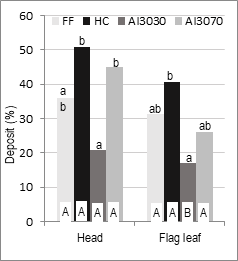
Figure 6: Broth deposit corrected by the coefficients on the head and flag leaf for each nozzle. ap11002: flat fan 11002; txa8002: hollow cone 8002; ai3030: air induction symmetric double fan 11002; ai3070: air induction asymmetric double fan11002. Lowercase letters on the columns indicate significant differences (p≤0.05) according to the Tukey test between nozzles in each application target. Different capital letters on the columns indicate significant differences (p≤0.05) according to the Tukey test between application targets for each nozzle.
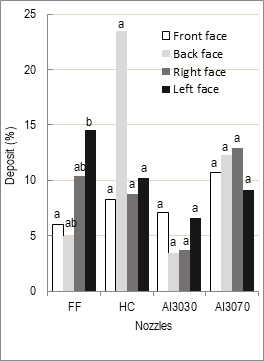
Figure 7: Broth deposit corrected by the coefficients on the head sides for each nozzle. ap11002: flat fan 11002; txa8002: hollow cone 8002; ai3030: air induction symmetric double fan 11002; ai3070: air induction asymmetric double fan11002. Different lowercase letters on the columns indicate significant differences (p≤0.05) according to the Tukey test between nozzles in each head face.
4. Conclusions
The results show the importance of selecting the nozzles according to the application target and the climatic conditions at the time. Angling 70º back improves coverage and the number of deposits on the stem compared to smaller angles. However, 30° forward angles do not improve penetration compared to the vertical position. The use of fine droplets and multiple directions, like those of the hollow cone nozzles, increases coverage and deposition both in the vertical and horizontal targets if the conditions of temperature, humidity, and wind speed allow it regarding the risk of exo-drift.
The evaluation methods used have advantages and disadvantages that are complementary when performing a complete analysis of the application characterization parameters. On one hand, the digital analysis of the water-sensitive paper allows characterizing the droplet spectrum applied and the uniformity of distribution; on the other hand, the use of tracers gives us precision in the amount of liquid collected, as mentioned by Cowell and others29.















